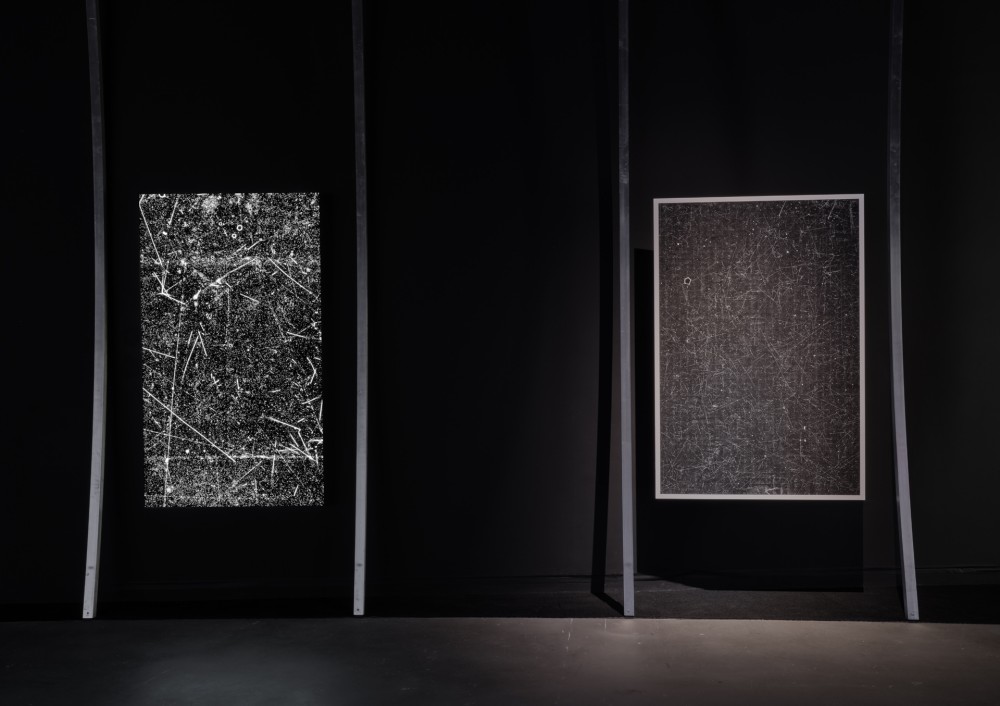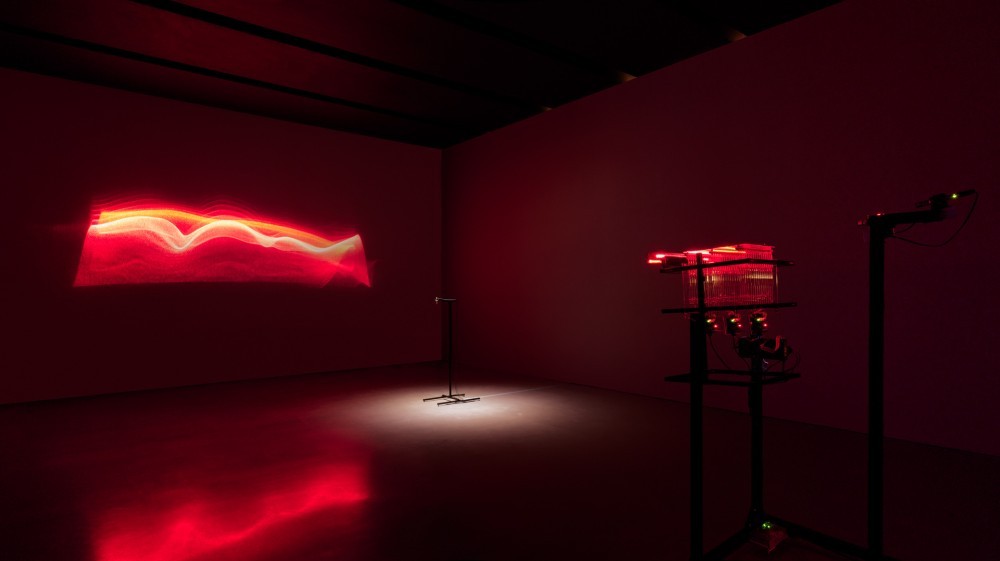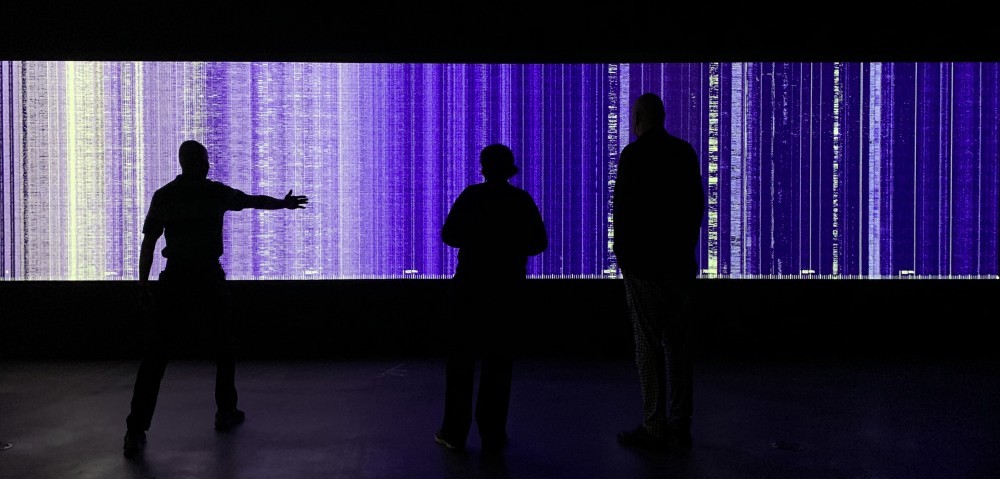
The exhibition Indivisible opens at New Media Gallery
The exhibition features artworks by Semiconductor and Yunchul Kim, former CERN artists in residence, Ralf Baecker and Richard Vijgen that capture, reveal and imagine the unseen processes constantly at work in the world around us.
The full complexity of the universe is invisible to human perception, filled with undetectable matter that follows astonishing rules and patterns. Questioning and searching for invisible or hidden dimensions has long been the pursuit and occupation of cultures, the sciences and the humanities. In this exhibition, four artists engage with science and technology to reveal a series of spellbinding, invisible landscapes.
Ancient cosmology was rooted in the meticulous and often poetic observation and interpretation of natural patterns and phenomena. Hundreds of thousands of years in the making, the most sensitive, sophisticated, and flexible instrument of observation may still be us; our frail bodies and creative minds. Evolving science and technologies allow us to extend our crude biologies, creating prosthetics and strategies that help us see beyond human perception into the dark reaches of space, through time and into the heart of matter. To this end, we have devised ways to capture invisible cosmic particles and proposed theories of dark energy and dark matter.
Through extraordinary work in the scientific realm, these award-winning artists capture and reveal the indivisible nature of our invisible and visible world. Four captivating landscapes recall the potential of creative minds to imagine new ways of seeing.
Geiger Müller tube, glass, aluminium, microcontroller
Argos is a glittering cosmic ray detector. Through flashing lights, the work visualizes the moments when invisible muon particles collide with the Geiger Muller tubes which are sensing and detecting a rain of ionizing radiation. Muons are cosmic particles similar to electrons but with 200 times the mass. They are created when cosmic rays slam into atoms in the earth’s atmosphere. Travelling at close to the speed of light, Muons shower the earth from all angles. Of all the particles that exist around us, muons are the only ones from space that make it to earth. When the invisible muon particles collide with the two Argosian heads we become aware of this tempestuous landscape, invisible to our eyes.
Yunchul Kim was the winner of the 2016 Collide Award, Arts at CERN's international residency programme. Argos was commissioned by Arts at CERN.
4K Single Channel Video Installation (silent) 16:34. Giclée Print on Bamboo Paper, 1099x1625
Through the AEgIS was created when the artists were residents at CERN. The work is a spacetime-lapse animation created from micro-photographs, as well as a giclée print. Captured by the AEgIS experiment at CERN (Antimatter Experiment, Gravity, Interferometry, Spectroscopy) the animation allows us to visualize a landscape of pions, protons and nuclear fragments flying out from annihilation sites. These tiny particles ionize a photographic plate which, when developed, reveal their turbulent trajectories over time. Using a special microscope with a super-shallow depth of field, this plate is ‘mined’ in two-micron steps, creating images which reveal the trajectories. The delicate lines and brilliant ‘explosions’ show us something extraordinary; violent collisions between matter and antimatter; a landscape too small for the human eye to see. A sublime, transcendental landscape at the micro-level.
Semiconductor received the 2015 Collide Award, Arts at CERN's international residency programme. Special thanks to Dr Michael Doser, experimental physicist at CERN.
Installation with Projection: custom electronics, muscle wires, laser module, fluxgate magnetometer
Mirage is a complex projection apparatus that uses principles from optics and artificial neural network research. The work generates a synthetic landscape based on how incoming data is perceived through a ‘fluxgate magnetometer’. This piece of kit registers the magnetic field of the earth, which is dependent on the earth geodynamo and its interactions with the activity of the sun, and then feeds this information into an unsupervised learning algorithm for analysis. The algorithm, inspired by the principle of a Helmholz Machine, “dreams” variations of the previously analyzed signals. These variations are translated into a two-dimensional matrix that physically transforms a thin mirror sheet through the actions of 48 muscle wire actors. The surface of the mirror sheet shifts from analogue to systems state. A thin laser line is directed onto the mirror surface at an acute angle to generate a beguiling, protean dreamscape. The work visualizes invisible fields and our connections with a distant solar body.
Produced with the support of LEAP Gallery, Berlin
Data Landscape/Interactive Installation
Hertzian Landscapes is a live visualization of the radio spectrum. Unlike visible light, waves in the radio spectrum cannot be perceived by us directly yet this space is teeming with human activity. Hertzian Landscapes employs a digital receiver to scan large swaths of radio spectrum in near real-time and visualizes thousands of signals into a panoramic electromagnetic landscape. Users can pick up and adjust specific frequencies by positioning themselves in front of the panorama as if controlling a radio tuner with their body. This gives a sense of walking through an invisible spectrum. From radio broadcasts to weather satellites; from medical implants to aeronautical navigation, the radio spectrum is divided into hundreds of designated slices each tied to a specific application. Based on a localized frequency database that describes these slices, signals are annotated to provide information about their theoretical type and application. The work visualizes a landscape that can be modelled visually and sonically, from gentle rain to agitated volley.
Hertzian Landscapes is supported by the Netherlands Institute for Sound and Vision and the Netherlands Creative Industries Fund.
Indivisible runs at New Media Gallery through 14 August, 20222. The exhibition is a partnership between New Media Gallery, the Swiss Consulate in Vancouver, Arts at CERN, and ISM. Indivisible was curated as part of the Innovation Fest.



